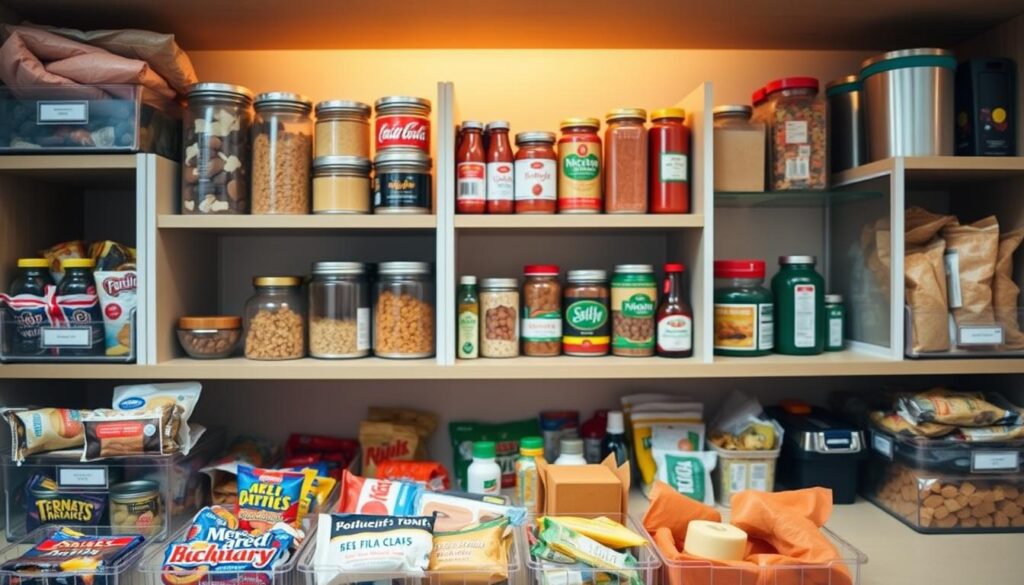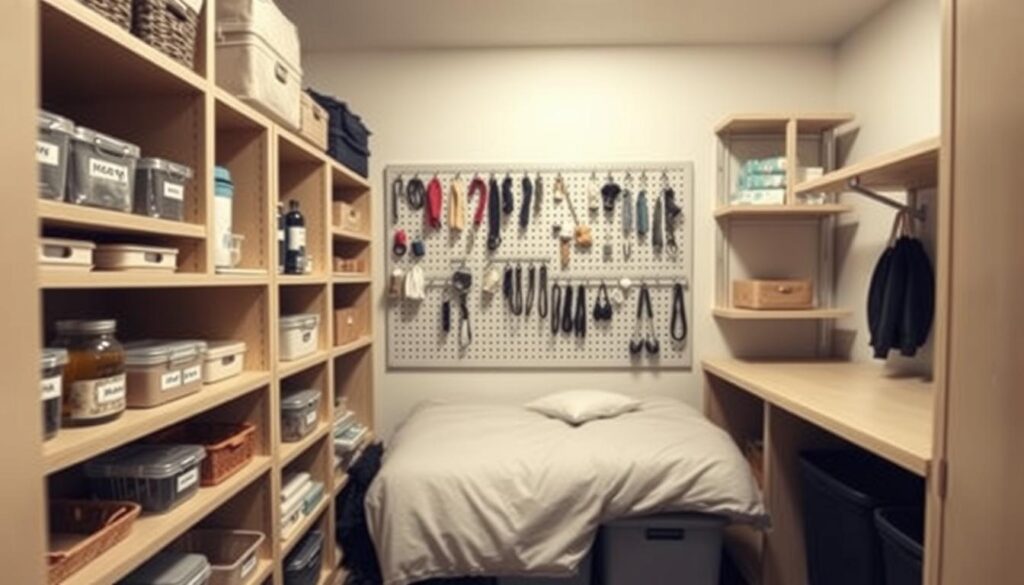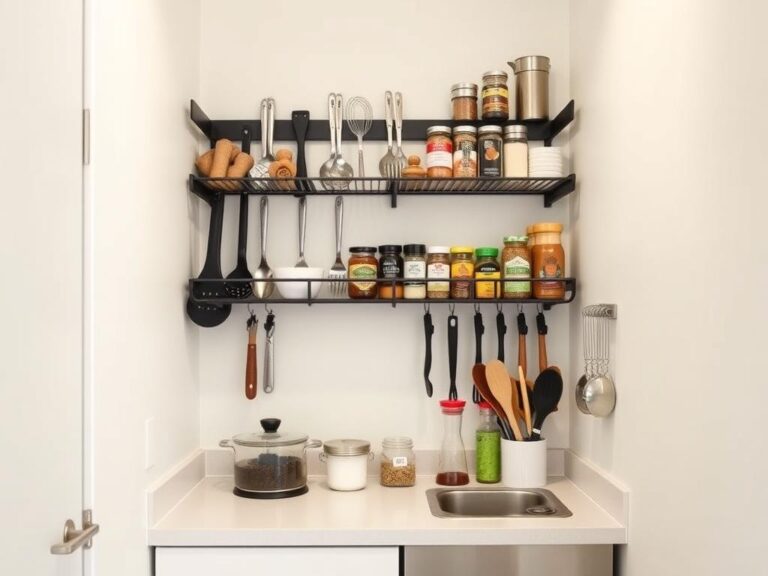How to organize snacks and pantry items in your dorm
Maximize your dorm space with our expert tips on dorm snack organization. Discover the best ways to store snacks and pantry items.
Living in a compact college space requires clever strategies to keep essentials tidy and accessible. Limited square footage means every inch counts, especially when storing food items you rely on daily. With the right approach, even the smallest areas can become efficient hubs that reduce clutter and stress.

Smart storage solutions are game-changers for maximizing vertical space and hidden corners. Twin XL underbed containers or modular cubes help stow bulk snacks while keeping them visible. Clear bins and stackable racks let you quickly locate items without rummaging through piles.
Creating a functional system starts with categorizing items by frequency of use. Daily grab-and-go treats belong in easy-to-reach spots, while less-used supplies can go in higher storage areas. This method ensures your setup remains practical as needs change during the semester.
Key Takeaways
- Compact living spaces demand creative use of vertical and underbed areas
- Clear containers and labeled sections improve visibility and accessibility
- Prioritize frequently used items in convenient locations
- Affordable products like collapsible organizers adapt to shifting needs
- A well-planned system reduces daily stress and saves time
Introduction: Why Dorm Room Organization Matters
Your college living space serves as both a study hub and personal sanctuary. How you arrange it impacts everything from morning routines to late-night study sessions. Strategic planning transforms cramped quarters into functional areas that support academic goals and social needs.
The Foundation of Daily Success
Students with orderly spaces report 34% less time spent searching for items according to recent surveys. This reclaimed time adds up across weeks, creating room for extra study sessions or social activities. Clear systems also reduce decision fatigue—a major contributor to college stress.
“When everything has a designated spot, I start each day focused instead of frustrated.”
What Else Would You Like to Know?
Choose below:
Crafting Harmony in Shared Spaces
Effective layouts prevent conflicts in tight living situations. Designated zones for personal and shared items help maintain boundaries while encouraging cooperation. Transparent containers and labeled shelves let roommates respect each other’s supplies without constant reminders.
| Factor | Organized Space | Cluttered Area |
|---|---|---|
| Study Efficiency | Focused sessions | Frequent distractions |
| Food Safety | Proper rotation | Expired items |
| Social Interactions | Positive vibes | Tension triggers |
Simple solutions like vertical shelving units or multi-purpose furniture make maintenance effortless. These approaches create visual calmness while keeping essentials within arm’s reach during busy weeks.
Understanding the Unique Challenges of Dorm Rooms
College housing presents specific logistical hurdles that test even the most prepared students. Shared living areas and strict building rules demand solutions tailored to tight quarters and shifting needs. Environmental factors like inconsistent heating or cooling add another layer of complexity to maintaining order.
Limited Space and High Demand for Essentials
Most campus residences measure under 200 square feet—smaller than a standard parking spot. This forces residents to store clothes, study materials, and food in overlapping zones. Built-in furniture rarely includes proper shelving for dry goods, leading to makeshift setups that consume valuable desk or floor areas.
| Challenge | Practical Fix |
|---|---|
| Shared common areas | Color-coded bins for personal items |
| No kitchen access | Stackable racks for non-perishables |
| Humidity issues | Airtight containers for snacks |
Overcoming Common Storage Obstacles
Temperature swings in older buildings can ruin sensitive items like chocolate or crackers within days. Many schools also prohibit over-the-door organizers or wall-mounted shelves, limiting vertical storage options. Students often adapt by using modular units that fit university-approved dimensions.
“We switched to clear, lidded boxes after losing three bags of chips to ants last semester.”
Portable carts and foldable crates work well for rotating snack inventories. These comply with fire codes while keeping frequently used items accessible near study areas. Regular check-ins with roommates help maintain systems as academic priorities shift.
Essential College Essentials for Your Dorm Room
Equipping your living space with the right tools transforms chaos into order during hectic semesters. Strategic picks help maintain structure while adapting to evolving academic needs. Let’s explore practical solutions that balance functionality with limited square footage.
Must-Have Items to Keep Your Supplies Neat
Clear plastic bins with locking lids top the list for visibility and pest protection. Their stackable design creates vertical storage towers in closets or under desks. Pair them with drawer dividers to separate tea bags from instant noodles without mixing flavors.
Over-the-door organizers work double duty for small spaces. Use pockets for single-serve oatmeal packs or spice jars, keeping counters clear. Multi-compartment caddies let you transport study fuel to common areas while keeping portions controlled.
| Product Type | Best For | Key Benefit |
|---|---|---|
| Airtight containers | Moisture-sensitive foods | Prevents spoilage |
| Label makers | Shared spaces | Reduces confusion |
| Modular cubes | Changing inventories | Customizable layouts |
Portable systems prove invaluable when moving between classes and late-night study groups. A junior communications major notes: “My rolling cart holds everything from ramen packs to highlighters – it’s basically my mobile command center.” Regular audits ensure your setup stays efficient as midterms approach.
Embracing Compact Living: Dorm Storage Hacks
Small living areas become functional when you use smart techniques tailored to their dimensions. Custom solutions turn overlooked spaces into efficient zones for essentials. Focus on products designed for academic housing constraints to maintain order without sacrificing style.
Utilizing Twin XL Underbed Storage
Specialized containers fit perfectly beneath elevated beds common in student housing. These low-profile bins hold bulk purchases like granola bars or instant noodles while keeping floors clear. Opt for versions with wheels to easily access items during late-night study sessions.

Maximizing Space with Modular Systems
Interlocking cubes adapt to unpredictable layouts and changing needs. Arrange them vertically as shelving units or horizontally under desks for meal supplies. One architecture student shares: “I reconfigure my cubes every finals week to hold extra coffee pods and protein bars.”
| Solution | Best Use | Space Saved |
|---|---|---|
| Vacuum bags | Bulky snacks | 50%+ |
| Magnetic strips | Spice jars | Wall surfaces |
| Hanging organizers | Single-serve items | Door backs |
Combine methods for maximum impact. Rolling carts slide into narrow gaps between furniture, while stackable containers create vertical towers. Regular inventory checks prevent overcrowding and expired items.
Practical Tips for Dorm Snack Organization
Effective food management in tight quarters starts with smart categorization. Keep essentials accessible by grouping similar items in labeled zones. Clear bins work wonders for creating a visual system that prevents chaos during busy weeks.
Creative Ideas to Optimize Snack Storage
Sort sweet, salty, and healthy options into separate containers. This method helps locate favorites quickly while preventing flavor mixing. A sophomore psychology student notes: “Color-coded bins stopped my roommate from accidentally eating my protein bars.”
Rotate stock using a first-in-first-out approach. Place newer purchases behind existing items to reduce waste. Stackable containers with secure lids protect opened packages from humidity and pests.
Track inventory with a simple list taped inside cabinet doors. Update it weekly to avoid duplicate purchases. Designate specific shelves for shared versus personal goods to maintain harmony in shared spaces.
| Challenge | Solution | Benefit |
|---|---|---|
| Limited surfaces | Wall-mounted baskets | Creates vertical space |
| Overcrowded shelves | Modular dividers | Customizable layouts |
| Forgotten items | Transparent jars | Instant visibility |
Use adhesive hooks to hang lightweight organizers near study areas. These keep grab-and-go portions within reach without cluttering desks. Regular system checks ensure your setup adapts to changing needs throughout the term.
Organization Ideas for Dorm Pantry Items
Innovative solutions can turn limited spaces into well-ordered pantries for students. Focus on multi-functional tools that adapt to various food storage needs while maintaining accessibility. Proper planning ensures every item has a logical home, even in compact living environments.
Optimizing Shelves and Cabinets for Pantry Goods
Elevate shelf efficiency with acrylic risers. These create staggered layers, making boxed meals and spice jars visible at a glance. Narrow pull-out drawers installed in deep cabinets prevent forgotten items. “I added sliding trays to reach my ramen packets without emptying the whole shelf,” shares a senior art student.
Innovative Uses for Storage Cubes
Repurpose modular cubes as custom pantry zones. Assign each cube to specific categories like breakfast foods or cooking essentials. Stack them horizontally under desks or vertically beside mini-fridges for quick access. Transparent fronts let you scan contents instantly.
| Solution | Purpose | Benefit |
|---|---|---|
| Tiered shelf risers | Vertical visibility | Fits 2x more items |
| Magnetic spice racks | Wall space use | Frees cabinet room |
| Color-coded bins | Category sorting | 5-second identification |
| Cube dividers | Portion control | Reduces overstocking |
Label makers help maintain systems in shared spaces. Assign specific colors for roommates’ goods to minimize mix-ups. Weekly rotations keep frequently used items at eye level while storing backups higher up.
Utilizing Dorm Bookshelves for Creative Storage
Transform standard shelving units into multifunctional hubs that support academic and nutritional needs. Bookshelves offer untapped potential beyond textbook displays when approached with strategic planning.
Blending Literature with Practicality
Mix study materials with food containers to create balanced storage zones. Place sturdy bins of dried fruit or pasta between book clusters for easy access. A junior history major shares: “Separating my philosophy texts from tea bags using decorative bookends keeps both categories visible.”
Add adjustable shelf inserts to double vertical capacity. These let you store bulkier items below while keeping frequently grabbed treats at waist level. Transparent acrylic risers help spot oatmeal packets behind novels without rearranging entire sections.
| Shelf Zone | Optimal Use | Access Frequency |
|---|---|---|
| Eye Level | Daily essentials | 5-10x/day |
| Upper Third | Backup supplies | Weekly |
| Lower Third | Heavy items | As needed |
Patterned fabric bins add style while concealing less attractive packaging. Use them for rarely accessed goods on top shelves. Position units between beds and desks to create natural room partitions in shared areas.
Rotate shelf contents monthly to match changing academic priorities. This maintains functionality during midterms and finals weeks. Regular updates prevent overcrowding while keeping favorite study fuels within arm’s reach.
DIY Dorm Storage Projects
Custom storage solutions don’t require expensive products or advanced skills. With basic materials and creativity, you can design systems that maximize every inch of your living area. These projects adapt to unique layouts while keeping essentials within reach during busy weeks.
Budget-Friendly, Customizable Solutions
Repurpose household items into functional organizers. Coffee cans become airtight containers for pasta when decorated with chalkboard labels. Large yogurt tubs store snack mixes while resisting moisture. “My vintage suitcase holds three months’ worth of tea bags under my bed,” notes a sophomore theater major.
Cardboard boxes wrapped in fabric create stylish bins for shelf organization. Use removable adhesive hooks to hang lightweight macramé nets for chips or fruit snacks. These solutions cost less than $10 but add personal flair to shared spaces.
Step-by-Step Guides for Beginners
Build wooden crates in 45 minutes using pre-cut boards and basic tools:
- Sand edges for smooth handling
- Assemble with waterproof wood glue
- Add casters for underbed mobility
| Solution | Materials Needed | Time Required |
|---|---|---|
| Pegboard System | Pegboard, hooks, paint | 1.5 hours |
| Fabric-Covered Boxes | Cardboard, fabric, glue | 20 minutes |
| Wall Nets | Rope, curtain rods | 35 minutes |
Rotate projects throughout the semester to match changing needs. Modular designs let you expand systems as you discover what works best in your unique space.
Incorporating a Storage Cart for Easy Access
Mobile storage solutions revolutionize how students manage essentials in tight quarters. Rolling carts serve as adaptable hubs that transition seamlessly between private and shared spaces. Their multi-level design and portability make them ideal for compact living arrangements.
Selecting Your Space-Saving Partner
Prioritize three-tier models with mixed shelf types. Solid surfaces handle canned goods and appliances, while wire baskets keep chips and fruit snacks fresh. Narrow frames (under 14 inches wide) slide effortlessly between beds and desks.
Locking wheels prove essential for stability when transporting heavy loads. A senior communications student shares: “My cart’s brake system stopped a cereal avalanche during midterm crunch time.” Measure vertical clearance to ensure carts tuck under furniture when not in use.
| Feature | Benefit | Consideration |
|---|---|---|
| Multi-tier design | Separates food types | Limit to 3 shelves |
| Locking casters | Prevents rollaways | Test brake strength |
| Push handles | Eases transportation | Ergonomic grips |
| Adjustable height | Fits tight spaces | Check bed clearance |
Transparent bins on upper levels provide quick visual access to daily essentials. Lower compartments securely store bulkier items like rice packs or cooking oils. Regular wipe-downs maintain hygiene in high-traffic areas.
Maximizing Underbed Space with Twin XL Storage
Unused areas beneath beds become goldmines for students mastering compact living. Twin XL dimensions demand precision when selecting containers to avoid wasted inches. Properly measured solutions turn this often-overlooked zone into a functional extension of your living area.
Precision Planning for Hidden Areas
Start by measuring height clearance and bed frame protrusions. Containers exceeding 6.5 inches tall often scrape against support beams. Opt for low-profile designs with smooth-gliding wheels to access items without strain.
Clear plastic bins with locking lids simplify inventory checks. A junior political science major shares: “Labeled sections help me grab microwave popcorn during study marathons without turning lights on.” Transparent sides eliminate guesswork while maintaining pest resistance.
| Container Type | Best Feature | Capacity |
|---|---|---|
| Rolling drawers | One-handed access | 20 lbs |
| Flat storage bags | Seasonal swaps | Bulky items |
| Modular trays | Adjustable dividers | Small portions |
Rotate stock quarterly using a simple tracking system. Store bulk purchases for later months beneath current supplies. Bed risers add 8 inches of vertical space for double-stacked containers during move-in weekends.
Maintain accessibility by keeping daily-use items near the bed’s edge. Less frequent backups belong toward the center. This layout prevents forgotten granola bars while maximizing every cubic inch.
Organizing Your Dorm Room with Versatile Cubes
Cube organizers provide flexible solutions for evolving student needs. These modular units adapt to any layout, creating custom storage zones that grow with changing priorities. Their lightweight design and interchangeable configurations make them ideal for maximizing tight quarters.
Adaptable Cube Configurations
Arrange units vertically to build space-saving towers for canned goods or study materials. Horizontal layouts transform into seating with hidden compartments for bulk items. One engineering student shares: “I created a breakfast station by stacking three cubes near my mini-fridge—oatmeal on top, utensils below.”
Fabric bins soften sharp edges while protecting fragile snacks like crackers or chips. Mix open and closed sections to display stylish containers while concealing mismatched packaging. Rotate layouts monthly to match shifting academic demands.
| Configuration | Best Use | Space Saved |
|---|---|---|
| Vertical Stack | Dry goods & supplies | 45% floor area |
| Bench Layout | Seating + bulk storage | Dual-purpose |
| Mixed Display | Frequent-use items | 30% cabinet space |
Label systems maintain order in shared environments. Use removable tags to update categories as inventories change. Regular adjustments keep your setup functional throughout the semester without major overhauls.
Smart Use of Dorm Storage Products for College Essentials
Choosing the right tools elevates campus living by merging practicality with visual appeal. Modern storage solutions help students maintain order while reflecting personal style, turning cramped quarters into intentional spaces that support academic success.
Combining Functionality with Aesthetics
Multi-purpose items like fabric ottomans with hidden compartments maximize utility without sacrificing floor space. These dual-use pieces provide seating while stashing bulk supplies out of sight. “My storage bench holds textbooks and ramen packs—guests never guess it’s functional,” notes a senior design student.
Prioritize neutral-toned containers that blend with any decor scheme. Textured baskets or metallic organizers add sophistication to basic shelving units. Durable materials like reinforced plastic ensure products withstand moves between housing units year after year.
| Product Type | Style Benefit | Practical Feature |
|---|---|---|
| Modular cubes | Mix-and-match colors | Expandable layouts |
| Stackable bins | Clean lines | Space efficiency |
| Glass jars | Display-ready | Air-tight seals |
Balance open and closed storage to highlight decorative items while concealing everyday essentials. Rotate seasonal pieces like patterned trays or themed organizers to refresh your space without major overhauls. This approach keeps systems adaptable as academic priorities shift.
Balancing Functionality and Style in Dorm Rooms
Modern campus living demands solutions that blend practicality with personal flair. Students now prioritize storage tools that serve dual purposes – keeping essentials accessible while reflecting individual style. This approach transforms cramped quarters into intentional spaces that spark joy during late-night study sessions.
Design Meets Daily Needs
Woven baskets with geometric patterns offer texture while hiding bulkier items like snack boxes. Pair them with transparent acrylic containers for frequently grabbed items – the contrast creates visual interest without clutter. A junior interior design student shares: “Natural materials make my room feel cozy, even when storing three types of cereal.”
Floating shelves with built-in LED strips showcase decorative plants alongside portioned snacks. This trend combines ambiance with utility, keeping items visible yet orderly. Opt for succulents or air plants that thrive in small spaces while purifying stale air.
| Design Element | Functional Benefit | Style Boost |
|---|---|---|
| Muted terracotta bins | Conceal mismatched packaging | Earth-toned aesthetic |
| Hexagon wall shelves | Hold spices & photos | Modern geometric lines |
| Macramé wall pockets | Store tea bags & sweeteners | Boho texture |
Gallery walls now incorporate miniature ledges for displaying protein bars or instant coffee pods. This clever hack turns necessities into decor while saving drawer space. Neutral storage pieces allow bold accent colors to pop through removable wallpaper or vibrant bedding.
Integ
Mastering small-space efficiency transforms daily challenges into opportunities. A well-designed system combines smart tools with intentional habits, creating harmony in limited areas. Consistency proves more valuable than complexity when maintaining order through demanding academic schedules.
Rotate storage solutions seasonally to match changing priorities. Lightweight bins work for summer sessions, while insulated containers handle winter bulk purchases. Weekly five-minute tidy-ups prevent overwhelming messes during finals.
Blend visibility with accessibility using vertical layouts. Transparent door pockets display quick breakfast options, while labeled drawers hide less-used supplies. One student notes: “Grouping my tea collection above my desk saves 10 minutes daily.”
Successful systems grow with your needs. Start simple, then expand components as you discover what maximizes your unique space. The right approach turns constraints into creative advantages that support both study goals and personal well-being.
FAQ
What are the best storage solutions for small dorm rooms?
How can I keep snacks fresh without a pantry?
Are DIY storage projects worth the effort for tight budgets?
What furniture maximizes space in shared living areas?
How do I prevent clutter in compact spaces?
Which products blend style with functionality for college spaces?
Tiny Kitchen, Big Ideas: Organizing Your Small Student Kitchen
» See exclusive tips for your home








